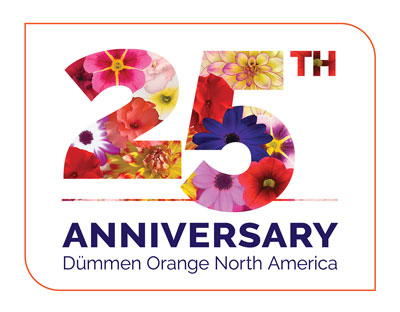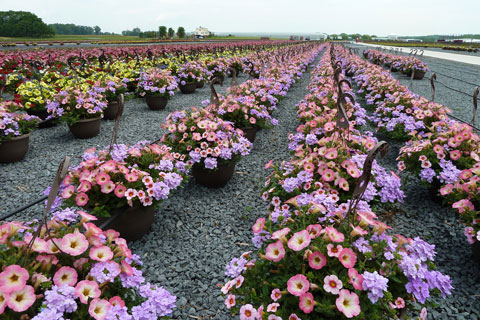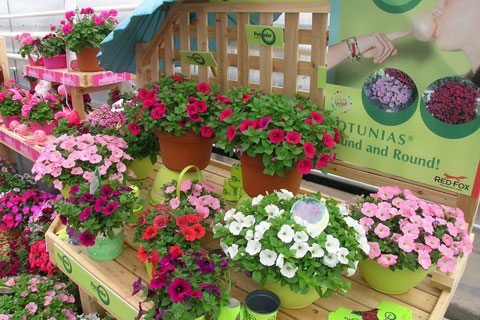1/1/2025
Fourth Time’s the Charm
Chris Beytes

Today, plant breeder and distributor Dümmen Orange is a mega-sized global player in the floriculture market, the result of numerous mergers, acquisition and venture capital investments that brought together multiple breeding companies and flowers brands, including Ecke, Fides, Oro Farms, Bartels Stek, Oglevee and more. But three decades ago, it was simply Dümmen, a 30-year-old family-owned German breeding company with four crops to its name—poinsettia, petunia, geranium and New Guinea impatiens—and about $10 million in sales, primarily in Germany and Holland, with a little bit in Italy.
In 1997, with expansion on their mind, the Dümmen family hired a young Dutchman, Perry Wismans, to expand commercial sales globally. America was high on his list. Perry began traveling to the U.S. monthly to learn the market and establish contacts. Over the next three years, he successfully established Dümmen Italy and Dümmen France. In America, he shook hands with three potential partners … but none of the deals worked out. The U.S. market was not like Europe.
“I had a few … (he pauses for thought) … ‘interesting building experiences’ about how to do things and how not to do things in those three years,” Perry said diplomatically.
What he learned was that, in order to make it in America, Dümmen needed its own boots on the ground … and an office.
 Pictured: Dümmen North America’s first office on 5544 Hilliard Rome Office Park in the suburbs of Columbus.
Pictured: Dümmen North America’s first office on 5544 Hilliard Rome Office Park in the suburbs of Columbus.
The Ohio Florists Association Short Course (today known as Cultivate) was, and is, the country’s largest greenhouse industry trade show. Its home is Columbus, Ohio, and Perry took that as a sound reason to make Dümmen’s home Columbus, too. That and the fact that their big trade show booth was very expensive to ship back to Germany for storage. A Columbus office would give them a place to set up shop in America and store their booth. Perry leased a small warehouse in a strip mall, hired an office manager and a couple of outside salespeople, and Dümmen North America was born.
“Dümmen had a few launches,” said Frank Magnusson, who joined the company in 2012 as finance manager and is now CEO for North America. “This fourth one was the charm.”
Dümmen began getting their foot in the greenhouse door, so to speak, and one such door was that of Kurt Weiss Greenhouses on Long Island. In his monthly travels to the states, Perry had already established a friendship with third-generation owner Russell Weiss, who took a liking to the young man and to the German-bred products he was representing (the Weiss family is of German descent). Russell made a five-year commitment to buy two million geraniums, two million poinsettias and two million New Guineas per year. The agreement was sealed with a handshake.
“That was the deal that allowed me to set up the office,” said Perry. “That made me feel comfortable because we had no money. I had to do business and have a certain turnover to make sure I could pay my bills!”
The Potunia
Early on, Perry and his small team were selling about 200,000 petunia cuttings in the U.S., but they couldn’t seem to get beyond that. All petunias had a simple problem: They were long-day plants that wouldn’t flower until May, when much of the spring sales period, especially in the south, was past. Perry had what he calls the “crazy” idea of trying to get a petunia to flower in January or February in Florida. Dümmen began selecting petunia varieties under those conditions, looking for earlier-flowering genetics.
After several years of crossing and selecting, the result was the Potunia series, which not only was daylength neutral, but also had a unique compact, ball-shaped habit that growers and retailers appreciated. They launched it at the OFA Short Course in Columbus in 2006. The industry must have liked it because Dümmen went from 200,000 to 20 million petunias in just a couple of years.

Pictured: Outdoor production of Confetti Garden hanging baskets at Battlefield Farms in Virginia in 2011, Confetti’s first full season in the market.
Confetti Gardens
The daylength-neutral petunias were a breakthrough and Dümmen was now breeding in more vegetative annual species, such as calibrachoa and verbena. Perry knew the market was crowded and it would be hard to get growers excited about yet another verbena series. He came up with the idea of offering a new product form: a multi-variety liner, which they dubbed Confetti Gardens. Confettis combined multiple species in one rooted liner—a unique way to get customers to grow Dümmen’s other spring annuals outside of geraniums and New Guineas.
Launched in 2010, Confetti had an unexpected side effect.
“When we started showing [Confetti] to retailers, they loved it,” said Perry. “At that time, the SKU was a 12-inch mixed hanging basket. And growers, depending on the region, made their own mixes. They didn’t promote a mix like Purple Cleopatra, which Walmart could do nationwide; they could go on television with it, they could do POP in the stores, all the stores could have the same mix. That was the result of the Confetti. It was a side effect, but it did boost our sales like crazy.”
So they patented Confetti. Actually, a utility patent.
 Talk about controversial! How do you patent the idea of multiple plants in one liner? It seems like an old idea. But as it turns out, there is no “prior art” (patent-speak for publicly available documentation of an idea) regarding the rooting of multiple species in one container. So the patent was valid. There is prior art on multiple colors of a single species, such as so-called “Easter Egg” mums and poinsettia combos. So liners of, say, three calibrachoa of different colors aren’t protected by the Confetti utility patent. Any company today selling multi-species liners does so under a licensing agreement with Dümmen.
Talk about controversial! How do you patent the idea of multiple plants in one liner? It seems like an old idea. But as it turns out, there is no “prior art” (patent-speak for publicly available documentation of an idea) regarding the rooting of multiple species in one container. So the patent was valid. There is prior art on multiple colors of a single species, such as so-called “Easter Egg” mums and poinsettia combos. So liners of, say, three calibrachoa of different colors aren’t protected by the Confetti utility patent. Any company today selling multi-species liners does so under a licensing agreement with Dümmen.
Pictured: First Potunia display at Dümmen’s first California Spring Trials, circa 2007.
After a long, successful career with Dümmen, including part ownership and involvement with the name change to Dümmen Orange in 2015, Perry is no longer officially part of the company (although he’ll be serving as chairman of the company’s advisory board starting January 1). Frank, who became head of North America in early 2024, is tasked with continuing the growth that Perry charted. What does he see for the next 25 years?
“I think our industry will go through an evolution for sure, but we want to be a premier presence within the industry, delivering value for our customers,” he answered. “Servicing our customers is our primary focus. That’s through our people and our products. We have a beautiful breeding and technology center in the Netherlands. We have a lot of resources invested in trait breeding, resistance breeding. That’s going to allow us to bring value to our customers—something that is different than a commoditized product.” GT